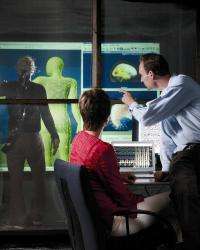The real avatar: Researchers use virtual reality and brain imaging to hunt for the science of the self

That feeling of being in, and owning, your own body is a fundamental human experience. But where does it originate and how does it come to be? Now, Professor Olaf Blanke, a neurologist with the Brain Mind Institute at EPFL and the Department of Neurology at the University of Geneva in Switzerland, announces an important step in decoding the phenomenon. By combining techniques from cognitive science with those of Virtual Reality (VR) and brain imaging, he and his team are narrowing in on the first experimental, data-driven approach to understanding self-consciousness.
In recent unpublished work, Blanke and his fellow researchers performed a series of studies in which they immersed subjects, via VR settings, into the body of an avatar, or virtual human. Each subject was fitted with an electrode-studded skullcap to monitor brain activity and exposed to different digital, 3D environments through a head-mounted stereoscopic visor or projections on a large screen.
Blanke and his colleagues then perturbed the most fundamental aspects of consciousness in their subjects, such as "Where am I localized in space" and "What is my body?" by physically touching their real-life volunteers either in or out of sync with the avatar. They even swapped perspectives from first to third person and put their male subjects inside female avatars, all the while measuring the change in brain activity. Use of electrical brain signals meant subjects could stand, move their heads, and (in the most recent experiments) walk with the VR on. Other techniques such as fMRI would have required them to remain still.
The team's results expand on clinical studies done in neurological patients reporting out-of-body experiences. And the data show marked changes in the response of the brain's temporo-parietal and frontal regions—the parts of the brain responsible for integrating touch and vision into a coherent perception -- compared to a series of control conditions.
"Traditional approaches have not been looking at the right information in order to understand the notion of the 'I' of conscious feeling and thinking," Blanke says. "Our research approaches the self first of all as the way the body is represented in the brain and how this affects the conscious mind. And this concept of the bodily self most likely came before more developed notions of 'I' in the evolutionary development of man."
A deeper understanding of the neurobiological basis for the self could lead to advances in the fields of touch and balance perception, neuro-rehabilitation, and pain treatments, contribute to the understanding of neurological and psychiatric disease, and have impacts on the fields of robotics and virtual reality.
But finding basic brain response to VR is just the beginning. Next up for the researchers is to induce stronger illusions of the self by altering signals of balance and limb position—two very powerful bodily cues. Once subjects can no longer distinguish between the real and the virtual self, cognitive science and brain imaging may be able to glimpse the causal mechanisms of self-consciousness and solve the mystery of the "I" once and for all.












